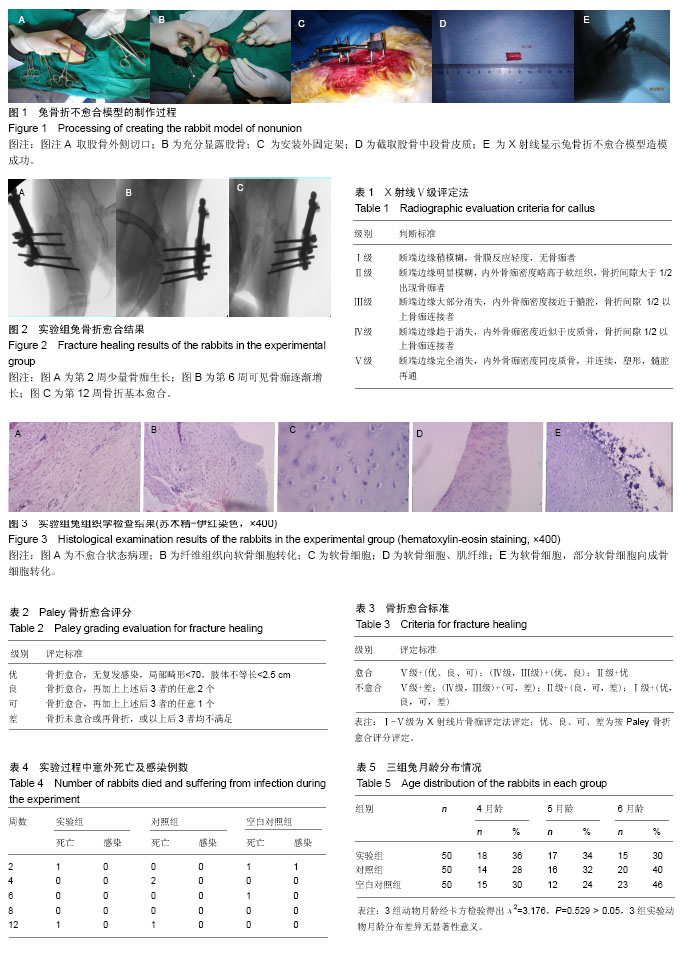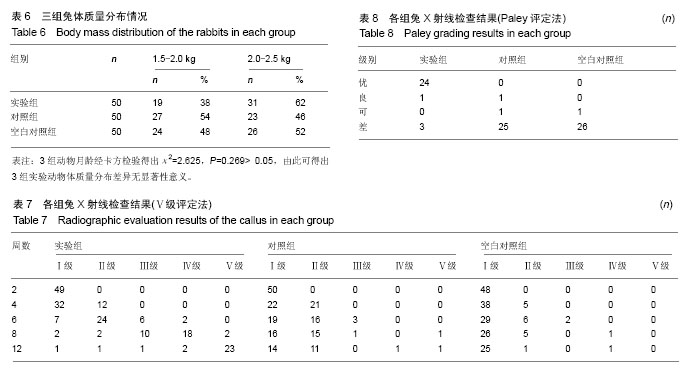中国组织工程研究 ›› 2018, Vol. 22 ›› Issue (32): 5175-5179.doi: 10.3969/j.issn.2095-4344.0384
• 组织构建实验造模 experimental modeling in tissue construction • 上一篇 下一篇
“手风琴”技术治疗骨折不愈合模型兔
冯 震1,张 猛2,吴薇娜3
- 承德医学院附属医院,1创伤骨科,2急诊科,3放射科,河北省承德市 067000
“Accordion” technology treats nonunion in model rabbits
Feng Zhen1, Zhang Meng2, Wu Wei-na3
- 1Department of Traumatic Orthopedics, 2Department of Emergency, 3Department of Radiology, Affiliated Hospital of Chengde Medical University, Chengde 067000, Hebei Province, China
摘要:
文章快速阅读:
.jpg) 文题释义:
“手风琴”技术:是近年来新兴起的治疗骨不连的一种技术。其创新的理念在于对不愈合的骨折断端不进行单纯的加压,而是一种依次应用加压、牵开再加压的方法联合两种不同的力学机制分别促进骨折愈合的方法,这种反复的加压-牵开-再加压的技术最早是由Giotakis教授提出的,同时被命名为“手风琴”技术。
“张力-应力”法则:活体组织在持续、稳定、缓慢的牵拉下,可刺激和激活某些组织细胞的再生和活跃生长,其生长方式类似胎儿组织,均为相同的细胞分裂。
文题释义:
“手风琴”技术:是近年来新兴起的治疗骨不连的一种技术。其创新的理念在于对不愈合的骨折断端不进行单纯的加压,而是一种依次应用加压、牵开再加压的方法联合两种不同的力学机制分别促进骨折愈合的方法,这种反复的加压-牵开-再加压的技术最早是由Giotakis教授提出的,同时被命名为“手风琴”技术。
“张力-应力”法则:活体组织在持续、稳定、缓慢的牵拉下,可刺激和激活某些组织细胞的再生和活跃生长,其生长方式类似胎儿组织,均为相同的细胞分裂。
.jpg) 文题释义:
“手风琴”技术:是近年来新兴起的治疗骨不连的一种技术。其创新的理念在于对不愈合的骨折断端不进行单纯的加压,而是一种依次应用加压、牵开再加压的方法联合两种不同的力学机制分别促进骨折愈合的方法,这种反复的加压-牵开-再加压的技术最早是由Giotakis教授提出的,同时被命名为“手风琴”技术。
“张力-应力”法则:活体组织在持续、稳定、缓慢的牵拉下,可刺激和激活某些组织细胞的再生和活跃生长,其生长方式类似胎儿组织,均为相同的细胞分裂。
文题释义:
“手风琴”技术:是近年来新兴起的治疗骨不连的一种技术。其创新的理念在于对不愈合的骨折断端不进行单纯的加压,而是一种依次应用加压、牵开再加压的方法联合两种不同的力学机制分别促进骨折愈合的方法,这种反复的加压-牵开-再加压的技术最早是由Giotakis教授提出的,同时被命名为“手风琴”技术。
“张力-应力”法则:活体组织在持续、稳定、缓慢的牵拉下,可刺激和激活某些组织细胞的再生和活跃生长,其生长方式类似胎儿组织,均为相同的细胞分裂。摘要
背景:“手风琴”技术治疗骨折不愈合在临床少量应用后效果显著,但还需要进一步的基础研究作为支持。
目的:验证“手风琴”技术可治疗新西兰大白兔骨不愈合。
方法:建立新西兰大白兔单侧股骨干缺损型非感染性骨折不愈合模型,造模成功后将新西兰大白兔随机分为3组,实验组大白兔应用“手风琴”技术:用外固定架以0.5 mm/d的速度持续加压至4周,第5,6周按照0.5 mm/d的速度对骨折断端进行持续牵开,牵开结束后仍以0.5 mm/d的速度进行持续加压4周;对照组对骨折断端复位后只进行加压;对空白对照组实验动物不愈合骨折断端进行复位并确保骨折远近端接触,但不进行任何牵张处理,既不加压,也不牵开。然后分别于2,4,6,8,12周分别对兔进行拍X射线片、拍片后对骨折断端取标本,进行苏木精-伊红染色并进行组织学观察。
结果与结论:①实验组X射线检查提示骨折愈合,而对照组及空白组仍骨折不愈合(P < 0.01);②组织学检查示实验组骨折不愈合部位可见明显由骨折不愈合状态向愈合状态的转变,最后骨折愈合,对照组及空白对照组未见明显骨折愈合变化;③结果表明,“手风琴”技术可简单、微创及高效地治愈骨折不愈合。
中国组织工程研究杂志出版内容重点:组织构建;骨细胞;软骨细胞;细胞培养;成纤维细胞;血管内皮细胞;骨质疏松;组织工程
ORCID: 0000-0002-7032-8939(冯震)
中图分类号:


.jpg) 文题释义:
“手风琴”技术:是近年来新兴起的治疗骨不连的一种技术。其创新的理念在于对不愈合的骨折断端不进行单纯的加压,而是一种依次应用加压、牵开再加压的方法联合两种不同的力学机制分别促进骨折愈合的方法,这种反复的加压-牵开-再加压的技术最早是由Giotakis教授提出的,同时被命名为“手风琴”技术。
“张力-应力”法则:活体组织在持续、稳定、缓慢的牵拉下,可刺激和激活某些组织细胞的再生和活跃生长,其生长方式类似胎儿组织,均为相同的细胞分裂。
文题释义:
“手风琴”技术:是近年来新兴起的治疗骨不连的一种技术。其创新的理念在于对不愈合的骨折断端不进行单纯的加压,而是一种依次应用加压、牵开再加压的方法联合两种不同的力学机制分别促进骨折愈合的方法,这种反复的加压-牵开-再加压的技术最早是由Giotakis教授提出的,同时被命名为“手风琴”技术。
“张力-应力”法则:活体组织在持续、稳定、缓慢的牵拉下,可刺激和激活某些组织细胞的再生和活跃生长,其生长方式类似胎儿组织,均为相同的细胞分裂。